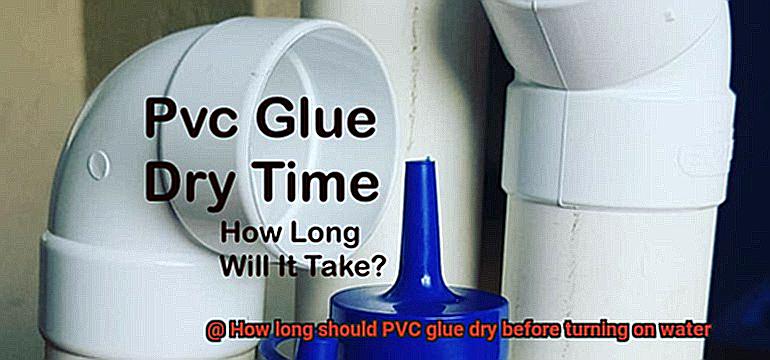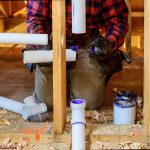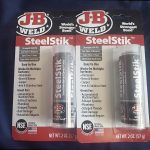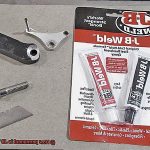Imagine this scenario: you’re knee-deep in a plumbing project, diligently fixing that annoying leak or embarking on an exciting installation. You’re almost there, just one step away from turning on the water and celebrating your triumph. But hold up. Have you given the PVC glue enough time to dry?
In the world of plumbing, timing is everything – a small oversight can lead to disastrous consequences. And one timing consideration that often gets overlooked is allowing sufficient drying time for PVC glue. Today, we’ll dive into this topic and discuss how long you should patiently wait before safely turning on the water.
So, gather ’round, eager plumbers and DIY enthusiasts alike, as we delve into the importance of patience when it comes to securing your PVC pipe connections. Let’s ensure your efforts won’t go down the drain – literally.

Drying Time of PVC Glue
Contents
- 1 Drying Time of PVC Glue
- 2 Factors Affecting the Drying Time of PVC Glue
- 3 Fast-Drying PVC Glues
- 4 Temperature and Humidity Impact on Drying Time
- 5 Maximum Strength After Drying Time
- 6 Pressurizing Before Recommended Drying Time
- 7 Advantages of Allowing Ample Time for Glue to Dry
- 8 Tips for Ensuring a Secure Joint with PVC Glue
- 9 Conclusion
Creating a secure and leak-free connection when joining PVC pipes and fittings requires the right glue and proper drying time. In this article, we will explore why the drying time of PVC glue is crucial and how factors like temperature, humidity, and manufacturer’s recommendations influence it.
Importance of Drying Time:
To avoid weak joints and costly repairs, allowing sufficient drying time for PVC glue is essential. Proper drying ensures a reliable plumbing system that can withstand water pressure and provide long-lasting performance.
Factors Influencing Drying Time:
- Temperature: Higher temperatures speed up solvent evaporation in PVC glue, resulting in faster drying times. Conversely, colder temperatures slow down the process. Stick to the manufacturer’s recommended temperature range for optimal results.
- Humidity: The humidity level affects drying time as well. Lower humidity facilitates quicker evaporation, while higher humidity can prolong it. In high humidity conditions, consider additional drying time before turning on the water supply.
- Manufacturer’s Recommendations: Each brand or type of PVC glue has specific instructions regarding drying time. Follow these recommendations to ensure proper bonding and avoid issues.
Recommended Drying Time:
In general, most PVC glues require a minimum drying time of 24 hours before turning on the water. This allows solvents to evaporate adequately for a strong bond between pipes and fittings. However, note that even after the recommended drying time, the glue may not be fully cured. It could take several days or weeks for the joint to reach its maximum strength.
Factors Affecting the Drying Time of PVC Glue
Are you tired of waiting around for your PVC glue to dry before you can use your newly connected pipes? Understanding the factors that influence the drying time of PVC glue can help you achieve a secure and leak-free connection in no time. In this blog post, we will delve into the key factors that affect the drying time of PVC glue, providing you with valuable insights to ensure a successful plumbing project.
Factor 1: Temperature and Humidity
The ambient temperature and humidity levels in your workspace significantly impact how quickly PVC glue dries. Higher temperatures and lower humidity levels accelerate the drying process, while lower temperatures and higher humidity can slow it down. To optimize drying time, refer to the manufacturer’s instructions for the recommended temperature and humidity range. By creating an ideal environment, you can expedite the process and avoid potential issues.
Factor 2: Type of PVC Glue
Not all PVC glues are created equal. Different types of glues have varying drying times. Fast-setting PVC glues are designed to dry within 10 to 30 minutes, making them perfect for quick plumbing fixes. Regular PVC glues typically take 1 to 2 hours to fully cure, while heavy-duty glues may require up to 24 hours. Understanding the properties of each type of glue ensures that you select the appropriate one for your project and plan accordingly.
Factor 3: Pipe Size and Thickness
The size and thickness of the PVC pipes being joined can also affect drying time. Larger pipes have a larger surface area, requiring more drying time for the glue to bond properly. Similarly, thicker pipes necessitate a longer drying period due to the increased amount of adhesive needed. It’s essential to be patient during this step to ensure a strong bond between the pipes.
Factor 4: Application Technique
The way you apply PVC glue can have a significant impact on drying time. Following the manufacturer’s instructions carefully, apply an even and thin layer of glue on both surfaces being joined. This technique promotes better adhesion and faster drying. Rushing through this step or applying too much glue can lead to longer drying times or weaker joints, compromising the integrity of your plumbing system.
Factor 5: Pressure and Stress on the Joint

One common mistake is applying pressure or stress on the joint before the PVC glue has fully dried. Premature movement or turning on the water can weaken the bond and lead to leaks. It is crucial to exercise patience and avoid any stress on the joint until the recommended drying time has elapsed. By allowing sufficient time for the glue to dry, you ensure a strong and durable connection that will stand the test of time.
Fast-Drying PVC Glues
If you’ve ever tackled a plumbing project, you know that waiting for glue to dry before turning on the water can feel like an eternity. But fear not, there is a solution – fast-drying PVC glues. These glues are specially designed to reduce waiting time and provide a strong bond between PVC pipes and fittings. In this blog post, we’ll dive into the advantages of using fast-drying PVC glues over traditional glues and explore how they can make your plumbing projects a breeze.
Advantage #1: Quick Drying Time
Fast-drying PVC glues are formulated with solvents that evaporate rapidly, speeding up the drying process. Unlike traditional water-based adhesives, these solvents allow the glue to dry within minutes to hours, significantly reducing the waiting time. Say goodbye to overnight drying and hello to getting your plumbing project completed in no time.
Advantage #2: Low Viscosity for Better Bonding
Another advantage of fast-drying PVC glues is their low viscosity. This means that these glues have a thinner consistency, allowing them to penetrate the surfaces of the pipes and fittings more effectively. The better coverage and contact between the adhesive and the PVC material result in a stronger bond. With fast-drying glues, you can have peace of mind knowing that your connections are secure.
Advantage #3: Drying Accelerators for Even Faster Results
To further speed up the drying process, many fast-drying PVC glues contain additives known as drying accelerators.
These additives help the solvents evaporate even quicker, ensuring that the glue dries within a shorter period. Just remember to follow the manufacturer’s instructions regarding drying time to achieve optimal results.
But Wait, There’s More.
While fast-drying PVC glues are designed to reduce waiting time, it’s important to note that they still require proper curing time before turning on the water supply. The curing process involves the complete chemical reaction of the adhesive, ensuring maximum strength and durability.
So, even though the glue may appear dry on the surface, patience is key to avoid premature stress on the joint. Follow the manufacturer’s instructions for the recommended curing time, which can range from a few hours to a full day.
Temperature and Humidity Impact on Drying Time
Well, fear not. Fast-drying PVC glues are here to save the day, reducing drying time and ensuring a strong bond. But what’s the connection between temperature, humidity, and drying time?
Let’s start with temperature. The ideal drying temperature for PVC glue is around 70°F (21°C). At this sweet spot, the glue cures efficiently. If it gets hotter, though, be cautious. Excessive heat can cause the glue to cure too quickly, leading to a weaker bond. And if it gets colder, brace yourself for a snail-paced drying process. In fact, if the temperature drops below 40°F (4°C), that glue might never dry.
Now let’s talk about humidity. Believe it or not, moisture in the air can make or break your drying time. High humidity levels slow down evaporation, prolonging the process. To get things moving, aim for a relative humidity level between 40% and 60%. In humid areas, whip out a dehumidifier or air conditioner to create a more favorable environment for speedy drying.
But hold on. Dry environments have their own challenges too. In these cases, you might need to up the humidity game. A humidifier or a light misting of water can help prevent the glue from drying too fast and compromising its strength.
Maximum Strength After Drying Time
Fear not, my friend. In this blog post, we will uncover the secrets behind achieving maximum strength after the drying time of PVC glue. By understanding the crucial role of drying time, the factors that affect it, and the recommended wait period, you’ll ensure a bond that can withstand even the mightiest water pressure. So grab your cape and let’s embark on this adhesive adventure.
The Crucial Role of Drying Time:
The drying time of PVC glue plays a vital role in determining the strength and durability of your bond. Rushing this process can result in a weak connection that may crumble under pressure or when exposed to water. Patience is indeed a virtue.
Factors Affecting Drying Time:
- Temperature: Our superhero glue thrives in temperatures around 70°F (21°C), where it dances its way to a flawless cure. However, in scorching heat, it may lose its grip on reality and weaken. On the other hand, freezing temperatures below 40°F (4°C) can halt drying altogether. Keep a watchful eye on the thermometer.
- Humidity: Humidity is like our sneaky villain, slowing down evaporation and stretching out the drying process. A relative humidity level between 40% and 60% is ideal for battling this foe. In humid areas, call upon the dehumidifier or air conditioner army to create an environment where drying becomes a breeze.
- Brand and Type of Glue: Different PVC glues may have varying drying times due to their specific formulations. Always consult the instructions provided by the manufacturer for accurate drying times.
Recommended Drying Time:

Generally, most PVC glues require at least 24 hours to dry before turning on the water. However, it is essential to follow the manufacturer’s instructions for precise drying times. In colder or more humid conditions, longer drying times may be necessary.
Enhancing the Bond:
Applying gentle pressure to the joint during the drying process can help enhance the strength of the bond. Just remember not to overdo it; we don’t want our glue to crack under pressure.
Inspect Before You Connect:
Once the recommended drying time has passed, visually inspect the joint to ensure that it is fully dried before turning on the water. If any signs of wetness or uncured glue are present, allow more drying time before proceeding with water usage.
Pressurizing Before Recommended Drying Time
Patience is a virtue, especially when it comes to working with PVC glue. Rushing the drying process and pressurizing pipes before the recommended time can lead to disastrous consequences.
In this blog post, we will explore the importance of following the recommended drying time, the potential risks associated with premature pressurization, and provide tips to ensure proper drying. So grab a cup of coffee, settle in, and let’s dive into the intricacies of plumbing perfection.
Understanding the Process:
Before we delve into the risks, let’s first understand how PVC glue works its magic. Chemically bonding pipes and fittings together, this glue creates a strong and watertight connection. However, the catch is that this chemical reaction requires sufficient time to fully develop and cure.
Risks of Pressurizing Too Soon:
Pressurizing pipes before the glue has dried completely can result in weakened joints and troublesome leaks. The force of water flowing through the system exerts stress on these immature connections, causing them to fail. Trust me; you don’t want to be caught in a torrent of water damage and costly repairs due to impatience.
Tips for Proper Drying:
- Follow Manufacturer’s Instructions: Each brand of PVC glue has its own recommended drying time. Take the time to read and diligently follow these instructions. Though it may seem tedious, it pays off in the long run.
- Consider Environmental Factors: Temperature, humidity, and ventilation can significantly impact drying time. In colder temperatures or high humidity environments, allow for additional drying time. Conversely, warmer temperatures or well-ventilated areas may require less time.
- Patience is Key: When in doubt, wait it out. If you’re uncertain about the drying time or if specific circumstances demand faster curing, consult with a professional plumber or refer to guidance from the manufacturer.
Advantages of Allowing Ample Time for Glue to Dry
In today’s fast-paced world, patience is a rare commodity. However, when it comes to plumbing, particularly working with PVC pipes or fittings, patience is not just a virtue – it’s an absolute necessity. Rushing the drying process of PVC glue can result in weak joints, leaks, and costly repairs. So, let’s delve into the advantages of allowing ample time for glue to dry.
Stronger Bond:
Imagine this: you’ve applied the PVC glue, connected the pipes, and are eager to move forward. But hold on. Giving the glue enough time to dry is crucial for creating a strong bond between the pipes or fittings. When undisturbed for an adequate period, the glue triggers a chemical reaction that forms a secure and durable connection. Patience pays off with a reliable plumbing system.
Enhanced Leak Prevention:
Dealing with leaks after investing time and effort into a plumbing project is nobody’s idea of fun. Allowing sufficient drying time for PVC glue significantly reduces the risk of leaks. When given enough time to cure, the adhesive creates a tight seal between pipes, preventing water from infiltrating through tiny gaps. Rushing the process can lead to weakened joints that may result in leaks or even bursts.
Time Efficiency:
You might think, “But waiting for glue to dry wastes precious time.” However, consider this: rushing the drying process may provide immediate access to water, but it can cause future problems like leaks or weak joints. These issues will require additional time and effort to fix. By exercising patience and allowing the glue to fully dry before using your plumbing system, you’ll save yourself from future repairs and potential water damage.
Improved Durability:
We all want our plumbing systems to withstand the test of time. Allowing PVC glue to dry properly contributes to the overall durability of your pipes and fittings. With enough time, the adhesive forms a robust bond that can withstand pressure, temperature changes, and physical stress over an extended period. This means fewer repairs and replacements in the long run, saving you time, money, and headaches.
Increased Safety:
Safety should never be compromised in plumbing. Rushing the drying process can compromise joint integrity, increasing the risk of leaks, bursts, and subsequent water damage. By exercising patience and giving the glue enough time to fully dry and set, you ensure a secure and stable connection that minimizes potential hazards. Your peace of mind is worth every minute of waiting.
Tips for Ensuring a Secure Joint with PVC Glue
Creating a secure joint when joining PVC pipes and fittings is vital for maintaining a leak-free and reliable plumbing system. In this article, we will explore some essential tips to help you achieve a secure joint using PVC glue. From choosing the right type of PVC glue to allowing sufficient drying time, these tips will ensure a strong and durable bond that can withstand water pressure and stand the test of time.
Choosing the Right Type of PVC Glue:
To start, it is crucial to select the right type of PVC glue for your project. Regular PVC cement, fast-setting cement, and primer/cleaner are common options available. Each type has its own purpose and drying time, so be sure to read and follow the manufacturer’s instructions for optimal results.
Preparing the Surfaces:
Properly preparing the surfaces being joined is key to ensuring a secure joint. Before applying PVC glue, make sure both surfaces are clean, dry, and free from any dirt, grease, or moisture. Use a cleaner specifically designed for PVC pipes or wipe the surfaces with a clean cloth soaked in rubbing alcohol. This step ensures better adhesion and removes any remaining debris.
Applying the PVC Glue:
When applying PVC glue, it should be done evenly and generously on both surfaces being joined. Use a brush or applicator designed for PVC glue to ensure an even application. Avoid applying excessive amounts of glue as it can lead to excess buildup and potential leaks. Follow the manufacturer’s instructions regarding application techniques and drying times to achieve optimal results.
Joining the Pipe and Fitting:
Once the glue has been applied, immediately join the pipe and fitting together. Ensure they are aligned correctly for a proper fit. You can twist or slightly turn them as they are pushed together, helping distribute the glue evenly for a secure joint.
Allowing Sufficient Drying Time:
The drying time for PVC glue can vary depending on factors such as temperature, humidity, and the specific type of glue being used. While most PVC glues require at least 24 hours of drying time before turning on the water, it’s best to refer to the manufacturer’s instructions for accurate drying times. Rushing the drying process can result in a weak or faulty joint, so be patient and allow ample time for the glue to dry and set properly.
Testing the Joint:
After the recommended drying time has passed, it is essential to test the joint before turning on the water fully. Visually inspect the joint for any signs of leaks or improper bonding. Gently tug or twist the joint to check for movement or weakness. If any issues are detected, it may be necessary to remove the joint, clean the surfaces, and reapply the PVC glue.
wxTq_5szm4g” >
Also Read: How To Glue PVC Pipe Without Primer?
Conclusion
The drying time of PVC glue before turning on the water is a crucial step in any plumbing project. It ensures a strong and leak-free connection that can withstand the pressure of flowing water. So, how long should you wait? Well, it depends on the type of PVC glue you are using and the specific conditions of your project.
Typically, most PVC glues require at least 24 hours to fully dry and cure before you can turn on the water. This allows the adhesive to bond with the pipe surfaces and create a secure seal. However, it’s important to note that drying times can vary based on factors such as temperature, humidity, and the thickness of the glue application.
In some cases, quick-drying PVC glues may claim to be ready for water usage in as little as 30 minutes. While these products offer convenience, it’s still advisable to give them a bit more time to ensure a reliable connection. Rushing this step could lead to leaks or weakened joints down the line.
To be absolutely certain that your PVC glue has dried adequately, it’s best to follow the manufacturer’s instructions provided on the product packaging. These guidelines will give you specific recommendations tailored to their particular glue formulation.
Remember, patience is key when it comes to plumbing projects. Taking the time to let your PVC glue dry properly will save you from potential headaches and costly repairs in the future.






